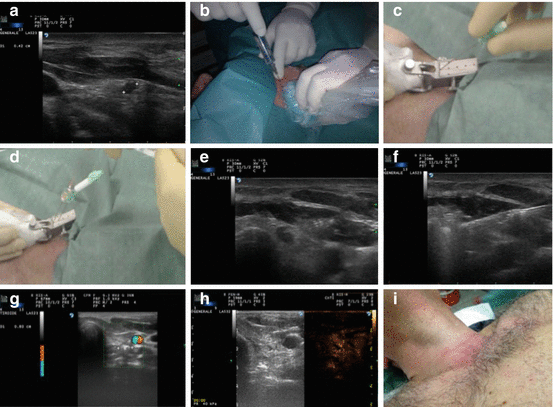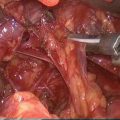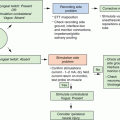Fig. 6.1
(a) Ultrasound scan of a large, prevalently solid, cold thyroid nodule (DM 4.6 × 2.3 × 3.7 cm vol 20.3 cc). (b) Under ultrasound monitoring, two optical fibres are inserted into the nodule and start laser firing. (c) After 600 s of energy delivery, colour-Doppler examination of the target lesions demonstrates a large area of thermal necrosis devoid of vascular signals. (d) Contrast-enhanced ultrasound, performed 24 h after treatment, clearly depicts a large area of tissue ablation with no evidence of blood supply
6.2 Experience
6.2.1 Cold Nodules
The feasibility of percutaneous laser thermal ablation was initially tested on animal models (New Zealand rabbits and laboratory pigs) [6]. After ex vivo studies on resected thyroid glands [6] that provided reproducible energy-damage curves, a feasibility study was performed on two human volunteers with large thyroid nodules immediately before their surgical resection. Since then, several non-randomised [9–11, 22–26] trials showed consistent results for LAT treatment of thyroid lesions. Cytological and histological samples, obtained by fine-needle aspiration, core needle biopsy or surgical resection, demonstrated in the treated lesions the presence of an area of complete coagulative necrosis surrounded by degenerative changes and inflammatory reaction. No evidence of extrathyroidal damage or cervical fibrosis along the needle tract was observed [26]. Two single-centre randomised studies compared the clinical and US changes induced by LAT with those observed in patients under thyroxine suppressive therapy or plainly followed-up [15, 27, 28]. Even if the first trial was conducted with a Nd:YAG and the second one with a diode laser source, both studies confirmed that a single laser treatment results in a nodule volume decrease greater than 40 % versus baseline at the 6- and 12-month US controls. No significant volume change was found in the suppressive therapy or in the control group.
In a retrospective study, volume reduction remained stable up to 5 years after the initial treatment and the majority of patients described a sustained improvement of their local symptoms after LAT [19]. A recent Italian multicentre prospective randomised trial provided a conclusive evidence of the outcomes of LAT in clinical practice [16]. The study assessed the long-term clinical efficacy, tolerability and predictability of outcome of LAT in four different centres operating according to the same procedure. Two hundred and one euthyroid patients with a solid not hyperfunctioning nodule were randomly assigned to a single laser session or to follow-up. Three years after LAT, in the active treatment group, mean nodule volume reduction was about 58 %. Thermal ablation induced a nodule decrease >50 % in nearly 70 % of cases and no significant difference in the outcomes was reported by the various centres. Presence of local symptoms decreased from 31 % at baseline to 5 % of cases 36 months after LAT, and cosmetic signs from 74 to 12 % of cases. The procedure was fairly well tolerated by most patients and the only major complication was one case of vocal cord paresis that self-resolved in 2 weeks. No changes in thyroid function or autoimmunity were observed. Hence, a single LAT session of solid thyroid nodules, performed by experienced operators, results in the majority of cases in a significant and persistent volume reduction and in the improvement of local symptoms in absence of late thyroid function changes.
6.2.2 Autonomously Functioning Thyroid Nodules
Initial reports on small series of hyperfunctioning thyroid nodules treated with LAT showed normalisation of thyroid function and effacement of the hyperfunctioning area at the post-ablation radioisotope scan [10, 14, 29, 30]. Data from larger studies, however, demonstrated that multiple laser treatments are necessary to normalise serum TSH levels [11, 17, 31]. In a prospective trial on hyperfunctioning nodules with suppression of extranodular parenchyma, laser ablation and radioiodine (131-I) treatment resulted in similar nodule shrinkage. It is noteworthy, however, that LAT induced the return to detectable levels of serum TSH in only 50 % of patients, a successful control of hyperfunction that was definitely lower than after 131-I treatment [18]. As a whole, these trials demonstrate an acceptable efficacy of laser ablation when treating small-size and mildly hyperfunctioning nodules [22]. On the other hand, in large hyperfunctioning thyroid lesions, normalisation of thyroid function is obtained less consistently and requires repeated laser treatments [11, 31].
A recent prospective controlled trial on large toxic thyroid nodules evaluated the efficacy of the combined treatment with a single laser ablation followed by 131-I therapy with respect to the rapidity of control of local symptoms and hyperthyroidism [32]. The reduction of 131-I activity administered 1 month after laser LAT was assessed versus a matched control group treated with radioiodine alone. After 2 years, nodule volume decrease was significantly higher in the combined treatment than in the control group (71.3 % vs 47.4 %, p < 0.001). Moreover, the use of a preliminary LAT allowed a >20 % decrease in the administered 131-I activity. The reduction of local symptoms was more rapid in the combined treatment group and, in three cases, no radioiodine therapy was needed after LAT. These data are of interest because in large hyperfunctioning thyroid lesions nodule shrinkage and the ease of pressure symptoms are rather slow after radioiodine treatment and the activities of 131-I required for treatment are usually elevated [32]. A combined treatment may be of use in large hyperfunctioning nodules because it allows a faster volume reduction and the disappearance of local symptoms, an earlier control of hyperthyroidism and permits the use of lower doses of 131-I in an outpatient treatment setting.
6.2.3 Cystic Lesions
Due to its high efficacy and safety and very low cost of percutaneous ethanol injection (PEIT) [17], few contributes are available on the use of LAT for cystic thyroid lesions.
In a recent trial, a series of cystic thyroid nodules were randomised to aspiration alone or to drainage followed by LAT [20]. After 6 months, a nearly complete disappearance of the cystic component was observed in 68 % of LAT patients as opposed to 18 % in the aspiration-alone group. Local symptoms improved significantly in the LAT patients as compared with the drainage-only group, and thyroid function remained unaffected in all cases. These results indicate a possible convenience of combined treatment with fluid aspiration followed by LAT in patients with large relapsing complex lesions with relevant solid component.
6.2.4 Cervical Recurrences of Thyroid Tumours
The majority of differentiated thyroid tumours are effectively treated by the initial surgical approach, with or without subsequent 131-I ablation of thyroid remnants. However, the recurrence rate during follow-up is up to 20 % in patients with differentiated thyroid tumours and is even higher in patients with medullary thyroid cancer [33]. In these last tumours and in some differentiated cancers, 131-I treatment is not effective in eradicating nodal metastases due to the absence of 131-I uptake. Part of the nonpalpable cervical metastases that are revealed by US examination of the neck, moreover, may be at difficult surgical reach. Some of these patients have already undergone repeat neck dissection and a further resection of nodal metastases may be technically difficult and at risk of surgical complications [33].
Due to the usually slow progression of the small-size cervical recurrences of differentiated thyroid carcinoma, MIT are currently under investigation for patients at elevated surgical risk [34].
LAT for thyroid malignancies was first tested in an elderly woman with undifferentiated thyroid carcinoma [6]. Repeated LAT sessions debulked large areas of the tumour, the patient underwent external beam radiation therapy and local symptoms improved for several months. A similar response to LAT was reported in a second inoperable anaplastic carcinoma, but in both cases the favourable course was transient and was followed by fatal outcome [35].
Favourable experiences with laser ablation have been reported small-size cervical recurrences of differentiated thyroid cancer [36]. A first series of eight cervical recurrences of papillary thyroid carcinoma in patients already submitted to cervical dissection was treated with a single session of Nd:YAG laser ablation with two optical fibres (Fig. 6.2). Twelve months after treatment, all the lymph node metastases showed a marked volume reduction (from 0.64 ± 0.58 to 0.07 ± 0.06 ml, p = 0.01) and the mean thyroglobulin levels decreased significantly from 8.0 ± 3.2 to 2.0 ± 2.5 ng/ml. Laser ablation was a rapid and usually well-tolerated procedure and no major complications were registered. These results were confirmed in a subsequent study performed in a different centre with the same technique [37]. Twenty-four metastatic lymph nodes (mean size 1.1 cm) from papillary cancer of the thyroid gland that relapsed after thyroidectomy and cervical dissection were enrolled in the study. All recurrences showed absent uptake at 131-I whole body scan but revealed a marked uptake at 18-FDG PET/TC. In most cases, LAT induced a marked shrinkage or the disappearance of the treated lesions at US and colour-Doppler examination and loss of 18-FDG uptake at the post-treatment PET/CT control.


Fig. 6.2
(a) Ultrasound scan of a small size (4 × 4 × 6 mm) nodal recurrence of papillary thyroid carcinoma (left laterocervical region, level IV); (b) ultrasound-guided local anaesthesia performed along the planned needle path; (c–e) insertion under ultrasound guidance of two spinal needles, progression of the optical fibres into the target lesion and subsequent laser firing; (f) complete effacement of the metastatic lymph node by the hyperechoic spots generated by gas microbubbles; (g–h) the metastatic lymph node is not revealed by post-treatment ultrasound controls; (i) absence of skin or subcutaneous damage after the end of the procedure
The issue concerning the opportunity to surgically treat papillary thyroid microcarcinomas (PTMC) incidentally revealed by imaging studies in fragile patients is still unsettled [38]. Due to their indolent course, indeed, a wait-and-see clinical management is frequently advocated for these cases. A feasibility study was performed on a solitary PTMC (8 mm in maximum diameter), with no US evidence of spreading outside the thyroid gland, in an elderly patient at high surgical risk because of liver and kidney failure. The small tumour was completely ablated with a single laser treatment without complications [39]. During a 2-year follow-up, US cervical examination and contrast-enhanced US scan demonstrated that the PTMC was completely replaced by a larger hypoechoic zone devoid of vascular supply. Both US-guided fine-needle aspiration biopsy and core-needle biopsy provided necrotic debris only with no viable neoplastic cells.
Despite the limited number of cases, LAT is a promising therapeutic tool for PTMC ablation in fragile patients at surgical risk and for isolated neck metastases from differentiated or medullary thyroid carcinoma in patients already treated with neck dissection. Laser ablation could be used for local recurrences that are not amenable to traditional surgical treatments for improving local symptoms or concern and for decreasing the bulk of tumour tissue prior to external radiation therapy or target therapy [34].
6.3 Tolerability and Safety
6.3.1 Tolerability
6.3.2 Complications
Subcapsular haematoma and dizziness may occur, even if infrequently [25, 40, 41]. Skin burn, cervical swelling, tracheal injury, transient hyperthyroidism and late hypothyroidism have been reported, but are definitely rare [25]. No pathological changes have been found in cervical tissues adjacent to the ablated area in patients who subsequently underwent surgery [6, 42].
Stay updated, free articles. Join our Telegram channel

Full access? Get Clinical Tree





